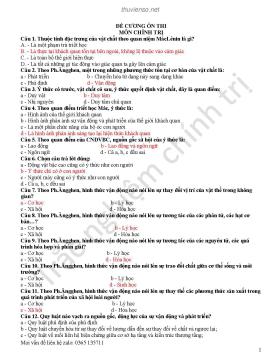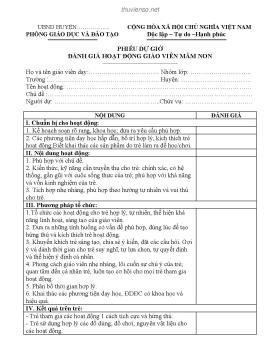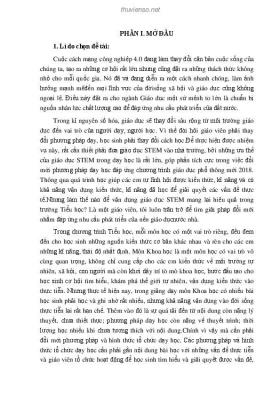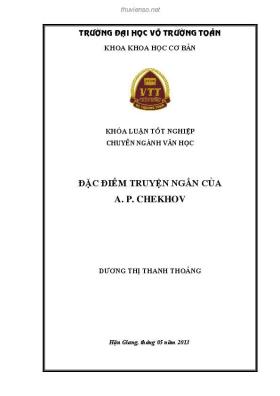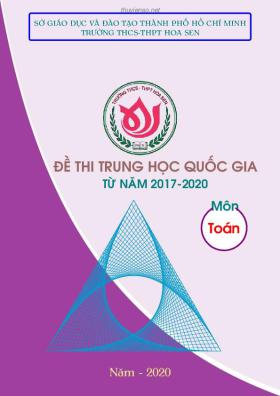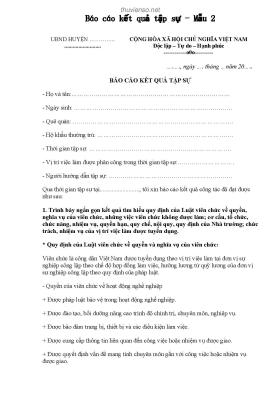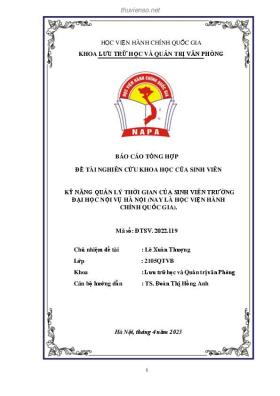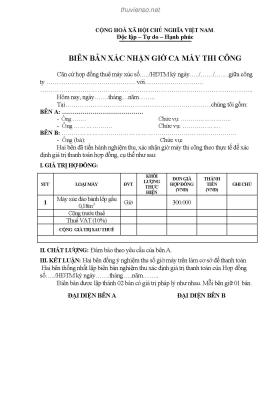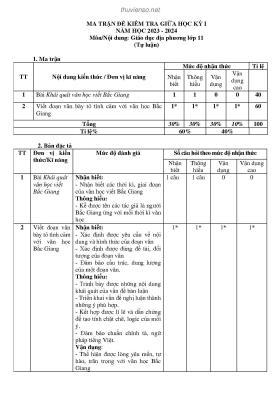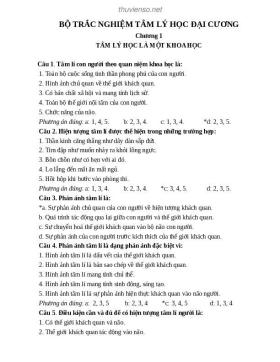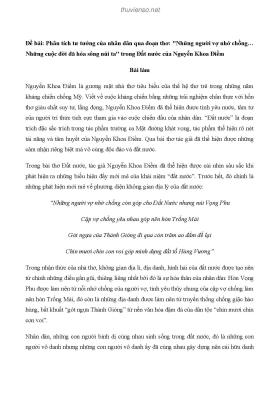
báo cáo khoa học: Association of hypoglycemic symptoms with patients’ rating of their health-related quality of life state: a cross sectional study
Số trang: 8
Loại file: pdf
Dung lượng: 404.26 KB
Lượt xem: 7
Lượt tải: 0
Xem trước 2 trang đầu tiên của tài liệu này:
Thông tin tài liệu:
Tuyển tập báo cáo các nghiên cứu khoa học quốc tế ngành y học dành cho các bạn tham khảo đề tài: Association of hypoglycemic symptoms with patients’ rating of their health-related quality of life state: a cross sectional study
Nội dung trích xuất từ tài liệu:
báo cáo khoa học:" Association of hypoglycemic symptoms with patients’ rating of their health-related quality of life state: a cross sectional study"Alvarez-Guisasola et al. Health and Quality of Life Outcomes 2010, 8:86http://www.hqlo.com/content/8/1/86 RESEARCH Open AccessAssociation of hypoglycemic symptoms withpatients’ rating of their health-related quality oflife state: a cross sectional studyFernando Alvarez-Guisasola1, Donald D Yin2, Gonzalo Nocea3, Ying Qiu2, Panagiotis Mavros2* Abstract Background: To evaluate the association between patient-reported hypoglycemic symptoms with ratings of their health-related quality of life state and patient-reported adverse events in patients with type 2 diabetes mellitus (T2DM). Methods: This observational, multicenter, cross sectional study was based on a sample of patients with T2DM from seven European countries who added sulfonylurea or thiazolidinedione to metformin monotherapy between January 2001 and January 2006. Included patients were required to have at least one hemoglobin A1c (HbA1c) measurement in the 12 months before enrollment and to not be receiving insulin. Demographic and clinical data from medical records were collected using case report forms. Questionnaires measured patient-reported hypoglycemic symptoms, health-related quality of life (EuroQol visual analogue scale, EQ-5D VAS), and treatment- related adverse events. Results: A total of 1,709 patients were included in the study. Mean patient age was 63 years, 45% were female, mean HbA1c was 7.06%, and 28% were at HbA1c goal (HbA1c < 6.5%). Hypoglycemic symptoms during the 12 months before enrollment were reported by 38% of patients; among whom 68% reported their most severe symptoms were mild, 27% moderate, and 5% severe. Adjusted linear regression analyses revealed that patients reporting hypoglycemic symptoms had significantly lower EQ-5D VAS scores indicating worse patient-reported quality of life (mean difference -4.33, p < 0.0001). Relative to those not reporting symptoms, the adjusted decrement to quality of life increased with greater hypoglycemic symptom severity (mild: -2.68, p = 0.0039; moderate: -6.42, p < 0.0001; severe: -16.09, p < 0.0001). Patients with hypoglycemia reported significantly higher rates of shakiness, sweating, excessive fatigue, drowsiness, inability to concentrate, dizziness, hunger, asthenia, and headache (p < 0.0001 for each comparison). Conclusions: Hypoglycemic symptoms and symptom severity have an adverse effect on patients’ rating of their health related quality of life state. Hypoglycemic symptoms are correlated with treatment-related adverse effects. Minimizing the risk and severity of hypoglycemia may improve patients’ quality of life and clinical outcomes. Results are subject to limitations associated with observational studies including the potential biases due to unobserved patient heterogeneity and the use of a convenience sample of patients.* Correspondence: panagiotis_mavros@merck.com2 Outcomes Research, Merck & Co., Inc., Whitehouse Station, NJ, USAFull list of author information is available at the end of the article © 2010 Alvarez-Guisasola et al; licensee BioMed Central Ltd. This is an Open Access article distributed under the terms of the Creative Commons Attribution License (http://creativecommons.org/licenses/by/2.0), which permits unrestricted use, distribution, and reproduction in any medium, provided the original work is properly cited.Alvarez-Guisasola et al. Health and Quality of Life Outcomes 2010, 8:86 Page 2 of 8http://www.hqlo.com/content/8/1/86 from a list comprising a convenience sample of physi-Background cians from each country.Hypoglycemia is a common complication of diabetes Eligible patients were identified for participation in themanagement that may adversely impact clinical out- study during the enrollment period, from June 2006 tocomes. Although improved glycemic control reduces the February 2007. Criteria for study eligibility were ages ≥risks of macrovascular and microvascular complications, 30 years, diagnosis with T2DM as defined by the Ameri-treatment aimed toward increasingly stringent, consen- can Diabetes Association, addition of a sulfonylurea orsus-guided glycemic targets may be associated with thiazolidinedione to metformin monotherapy on a datehypoglycemia [1-3]. While the risk of hypoglycemia is (index date) from January 2001 to January 2006, and atparticularly elevated in patients receiving insulin ther- least one hemoglobin A1c (HbA1c) measurement in theapy, patients with type 2 diabetes mellitus (T2DM) trea- 12-month period before the enrollment date [15].ted with insulin secretagogues (e.g., sulfonylureas, ...
Nội dung trích xuất từ tài liệu:
báo cáo khoa học:" Association of hypoglycemic symptoms with patients’ rating of their health-related quality of life state: a cross sectional study"Alvarez-Guisasola et al. Health and Quality of Life Outcomes 2010, 8:86http://www.hqlo.com/content/8/1/86 RESEARCH Open AccessAssociation of hypoglycemic symptoms withpatients’ rating of their health-related quality oflife state: a cross sectional studyFernando Alvarez-Guisasola1, Donald D Yin2, Gonzalo Nocea3, Ying Qiu2, Panagiotis Mavros2* Abstract Background: To evaluate the association between patient-reported hypoglycemic symptoms with ratings of their health-related quality of life state and patient-reported adverse events in patients with type 2 diabetes mellitus (T2DM). Methods: This observational, multicenter, cross sectional study was based on a sample of patients with T2DM from seven European countries who added sulfonylurea or thiazolidinedione to metformin monotherapy between January 2001 and January 2006. Included patients were required to have at least one hemoglobin A1c (HbA1c) measurement in the 12 months before enrollment and to not be receiving insulin. Demographic and clinical data from medical records were collected using case report forms. Questionnaires measured patient-reported hypoglycemic symptoms, health-related quality of life (EuroQol visual analogue scale, EQ-5D VAS), and treatment- related adverse events. Results: A total of 1,709 patients were included in the study. Mean patient age was 63 years, 45% were female, mean HbA1c was 7.06%, and 28% were at HbA1c goal (HbA1c < 6.5%). Hypoglycemic symptoms during the 12 months before enrollment were reported by 38% of patients; among whom 68% reported their most severe symptoms were mild, 27% moderate, and 5% severe. Adjusted linear regression analyses revealed that patients reporting hypoglycemic symptoms had significantly lower EQ-5D VAS scores indicating worse patient-reported quality of life (mean difference -4.33, p < 0.0001). Relative to those not reporting symptoms, the adjusted decrement to quality of life increased with greater hypoglycemic symptom severity (mild: -2.68, p = 0.0039; moderate: -6.42, p < 0.0001; severe: -16.09, p < 0.0001). Patients with hypoglycemia reported significantly higher rates of shakiness, sweating, excessive fatigue, drowsiness, inability to concentrate, dizziness, hunger, asthenia, and headache (p < 0.0001 for each comparison). Conclusions: Hypoglycemic symptoms and symptom severity have an adverse effect on patients’ rating of their health related quality of life state. Hypoglycemic symptoms are correlated with treatment-related adverse effects. Minimizing the risk and severity of hypoglycemia may improve patients’ quality of life and clinical outcomes. Results are subject to limitations associated with observational studies including the potential biases due to unobserved patient heterogeneity and the use of a convenience sample of patients.* Correspondence: panagiotis_mavros@merck.com2 Outcomes Research, Merck & Co., Inc., Whitehouse Station, NJ, USAFull list of author information is available at the end of the article © 2010 Alvarez-Guisasola et al; licensee BioMed Central Ltd. This is an Open Access article distributed under the terms of the Creative Commons Attribution License (http://creativecommons.org/licenses/by/2.0), which permits unrestricted use, distribution, and reproduction in any medium, provided the original work is properly cited.Alvarez-Guisasola et al. Health and Quality of Life Outcomes 2010, 8:86 Page 2 of 8http://www.hqlo.com/content/8/1/86 from a list comprising a convenience sample of physi-Background cians from each country.Hypoglycemia is a common complication of diabetes Eligible patients were identified for participation in themanagement that may adversely impact clinical out- study during the enrollment period, from June 2006 tocomes. Although improved glycemic control reduces the February 2007. Criteria for study eligibility were ages ≥risks of macrovascular and microvascular complications, 30 years, diagnosis with T2DM as defined by the Ameri-treatment aimed toward increasingly stringent, consen- can Diabetes Association, addition of a sulfonylurea orsus-guided glycemic targets may be associated with thiazolidinedione to metformin monotherapy on a datehypoglycemia [1-3]. While the risk of hypoglycemia is (index date) from January 2001 to January 2006, and atparticularly elevated in patients receiving insulin ther- least one hemoglobin A1c (HbA1c) measurement in theapy, patients with type 2 diabetes mellitus (T2DM) trea- 12-month period before the enrollment date [15].ted with insulin secretagogues (e.g., sulfonylureas, ...
Tìm kiếm theo từ khóa liên quan:
báo cáo khoa học báo cáo y học công trình nghiên cứu về y học tài liệu về y học cách trình bày báo cáoTài liệu liên quan:
-
HƯỚNG DẪN THỰC TẬP VÀ VIẾT BÁO CÁO THỰC TẬP TỐT NGHIỆP
18 trang 361 0 0 -
63 trang 338 0 0
-
13 trang 268 0 0
-
Báo cáo khoa học Bước đầu tìm hiểu văn hóa ẩm thực Trà Vinh
61 trang 255 0 0 -
Hướng dẫn thực tập tốt nghiệp dành cho sinh viên đại học Ngành quản trị kinh doanh
20 trang 250 0 0 -
Tóm tắt luận án tiến sỹ Một số vấn đề tối ưu hóa và nâng cao hiệu quả trong xử lý thông tin hình ảnh
28 trang 226 0 0 -
Đồ án: Nhà máy thủy điện Vĩnh Sơn - Bình Định
54 trang 223 0 0 -
23 trang 218 0 0
-
NGHIÊN CỨU CHỌN TẠO CÁC GIỐNG LÚA CHẤT LƯỢNG CAO CHO VÙNG ĐỒNG BẰNG SÔNG CỬU LONG
9 trang 217 0 0 -
Đề tài nghiên cứu khoa học và công nghệ cấp trường: Hệ thống giám sát báo trộm cho xe máy
63 trang 214 0 0


